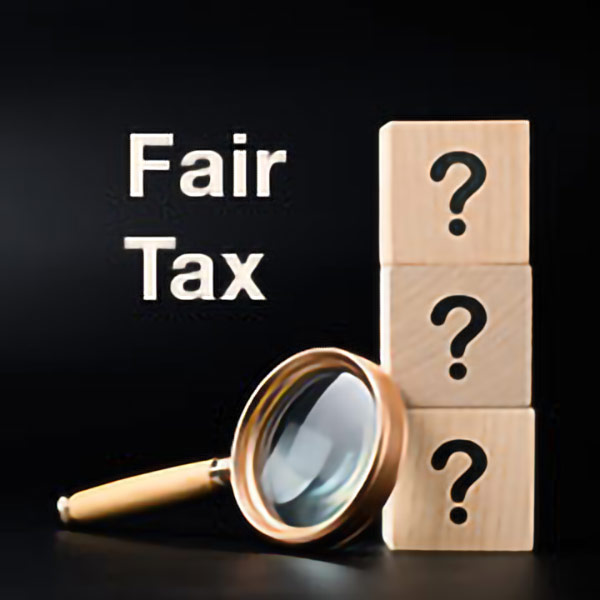Demystifying Fair Tax Proposals
This election season, the candidates are putting forth all sorts of tax proposals. One such proposal you may hear about is referred to as fair tax, also known as consumption tax. Here’s what you should know to understand how fair tax proposals might play out.

Fair Tax History
The fair tax concept has been around for some time. It was first introduced in Congress in 1999 and has since been reintroduced in every session of Congress. Most recently, the FairTax Act of 2023 (H.R. 25) was introduced in January 2023.
This bill would impose a national sales tax on domestic use or consumption of taxable property or services. It would eliminate the current income, payroll, and estate and gift taxes. The federal sales tax would apply to almost everything you purchase, including items usually exempt from state sales tax, such as food, housing and medical expenses. None of the existing deductions or tax credits would be available to offset the national sales tax.
Under the most recent bill, the sales tax rate would be 23% in 2025 and would be adjusted in subsequent years. It’s important to note that the rate is “tax inclusive” — that is, it’s applied to both the purchase price and the tax itself. In other words, it’s effectively a 30% tax on the purchase price. For example, the tax on a $100 purchase would be $30, for a total price of $130. Put another way, $30 is 23% of $130.
The bill also provides for monthly sales tax rebates known as the “family consumption allowance,” based on criteria related to family size and poverty guidelines. The rebates are intended to offset the tax costs on the purchase of necessities.
Individual states would be responsible for administering, collecting and remitting the sales tax to the U.S. Department of the Treasury. Then tax revenue would be allocated among the following categories:
- General revenue,
- Old-age and survivors insurance trust fund (Social Security),
- Disability insurance trust fund,
- Hospital insurance trust fund, and
- Federal supplementary medical insurance trust fund.
The bill would provide states an administrative credit of 0.25% of taxes remitted. It also would eliminate the IRS. And it would terminate the national sales tax if the Sixteenth Amendment to the Constitution, which authorizes an income tax, isn’t repealed within seven years after the enactment of the bill — which would presumably mean no federal taxes of any kind.
Case for the FairTax Act
The bill’s proponents claim a fair tax system would have numerous benefits. For example, they praise its simplicity compared with the current system. No longer would taxpayers be burdened with the complicated annual income tax filings, nor would employers have to deal with tax withholding and remittance. Workers would keep their entire paycheck and pay tax on only what they spend.
In addition, investment growth and earnings would grow tax-free. This could encourage investing and saving. Net profits for businesses would likely jump, as their income and payroll tax bills disappeared, and they passed along much of their own sales taxes to customers. Supporters contend that the lack of taxes on capital and labor also could cause offshore manufacturers to return to the United States.
Supporters similarly believe offshore dollars will be repatriated under a fair tax system because doing so won’t trigger a taxable event. This could boost capital spending and productivity.
Case against the FairTax Act
Opponents argue that a national sales tax would favor the wealthy and widen the income gap. High-income individuals generally spend a smaller portion of their income on consumption than less wealthy people. As a result, high-income people would pay a smaller share of their income in tax (while presumably receiving the rebate). Further, none of the existing deductions and tax credits would be available to offset the national sales tax or encourage desirable behaviors, such as charitable giving.
Some critics also claim that a fair tax won’t generate sufficient federal revenue. They say the fair tax rate would need to be much higher to generate the same amount of revenue that the current tax system produces. It also might prompt some people to minimize their taxes by purchasing more foreign goods and services.
Opponents voice concerns about shifting the tax administration burden to states, too. They question whether the administrative credit would cover states’ costs. While most states already have sales tax systems, they generally don’t cover all the goods and services that would be subject to a national sales tax and involve significantly smaller sums of money. Moreover, the cost of the administrative credits may not actually be lower than the cost of operating the IRS.
Future of the Fair Tax
For now, the odds of passing a national consumption tax aren’t promising. At this point, neither of the presidential candidates are advocating for the FairTax Act. The most recent bill gathered only a handful of co-sponsors in the House of Representatives. Likewise, a few states have explored fair tax options in recent years, but none of the proposals have gotten traction in state legislatures. One hurdle fair tax proposals face is a lack of understanding from legislators and the general public. This overview provides you with knowledge to help develop an educated stance on this tax issue.

